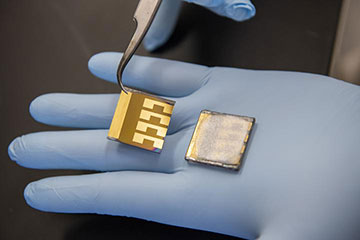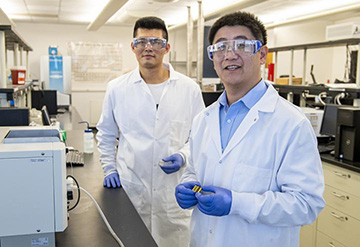
Two solar cell samples, one (right) with a protective lead-absorbing film applied to the back. [Image: Northern Illinois University]
For implementing competitive green-energy technologies, the winning combination is high efficiency at a low price point. Perovskite solar cells (PSCs) offer such promise for solar energy, but the lead content of most PSCs has raised concerns over possible environmental and health risks—which has stymied commercialization.
Researchers at Northern Illinois University (NIU), USA, and the U.S. Department of Energy's (DOE) National Renewable Energy Laboratory believe they may have found a way to reduce the risk of lead leaching from PSCs. The U.S. team has developed protective lead-absorbing films for the cells that are easy to apply and do not lower efficiency (Nature, doi: 10.1038/s41586-020-2001-x).
The lead-toxicity bottleneck
PSCs are rising stars in the renewable-energy community. Although the technology is only about a decade old, scientists have ramped up power conversion efficiency from about 3% in the early days of PSCs to more than 24% in 2019, according to the U.S. DOE. At those levels, PSCs are competitive with other photovoltaic technologies, such as silicon-based cells. They may even have strategic production advantages over other alternatives. Silicon cells, for example, require extremely high temperatures and precise processes to manufacture, while perovskite cells can be fabricated using room-temperature solutions.
While PSCs could be highly efficient, they’re not yet thought of as commercially competitive for a number of reasons. One is that the chemistry of the most efficient PSCs tends to prominently feature lead—and lead toxicity is “one of the most vexing, last-mile challenges in the perovskite solar cell field," according to NIU team leader Tao Xu, quoted in a recent press release.
A typical 550-nm-thick lead-based PSC may contain around 0.75 g/m2 of lead—an order of magnitude less than the lead-based paints outlawed nearly 50 years ago (10 g/m2), but still enough to warrant concern. It’s conceivable that damaged solar cells could leach lead into groundwater and soil.
Coating the cell stack

NIU solar cell researchers Xun Li (left) and Tao Xu. [Image: Northern Illinois University]
A standard PSC stack consists of several layers—a glass substrate with a conductive coating, followed by a semiconductor layer, a perovskite layer, a hole transport material and a metal electrode layer. If the cell becomes submerged, water can seep into the perovskite layer, carrying lead with it as water flows back out.
To protect against this possibility, the researchers deposited a transparent lead-absorbing film, containing lead-binding phosphonic acid groups, onto the glass side of a standard PSC stack. The metal side, which doesn’t need to be transparent, was coated with a less costly polymer film blended with lead-chelating agents. The metal side was also coated with a standard photovoltaic packing film.
The films are insoluble in water, the researchers note, so although they are permeable, they maintain structural integrity and do not dissolve when submerged. The absorbing layers swell to take in the lead once soaked in water, allowing for easy lead extraction once a cell has been damaged.
Hammers and razors
The scientists did not hold back during lab tests—scratching the back of the solar cells with razor blades and hammering the front-side glass until it shattered. Then, they submerged the damaged cells, coated with the protective layers, underwater and measured the coatings’ efficacy, finding that the films absorbed more than 96% of lead leakage at both room temperature and 50 °C.
Further experiments confirmed that the protective coatings do not affect cell performance or long-term stability, and that they’re effective in both pure and acidic water. The team also notes that the transparent film performed equally well at varying thicknesses ranging from 1.97 to 6.89 µm.
In fact, according to Xu, the top-layer film actually improves the transparency of the solar cell “just a bit” by being anti-reflective, allowing more light to be absorbed by the perovskite layer.
Patent pending
This on-device sequestration approach can be readily applied to current PSC configurations, according to the researchers, using off-the-shelf materials. Of note, they say, is that this approach is not limited to solar cells. The protective films could be applied to other perovskite-based technologies, such as solid-state lighting, display and sensor applications.
The team has applied to patent the films, and the DOE Solar Energy Technologies Office—which supported this work along with the National Science Foundation—will fund further development of the technology.
